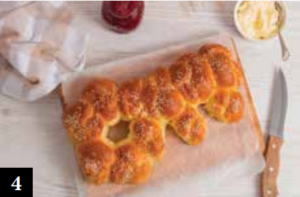Shlissel Challah

THE SHLISSEL CHALLAH
On the first shabbat after Passover there is a tradition of baking a special challah in the shape of a key or with a key baked inside. This is known as shlissel challah as shlissel is the Yiddish word for “key.” To quote the Sefer HaTodah by R’Eliyahu Kitov, “The Shabbat after Pesach when we announce the coming of Iyar, some… have the custom to make challah in the form of a key and to sprinkle it with sesame seeds. This is to remind us of the Mahn [manna] that began falling (in the desert) in the month of Iyar; it also symbolizes that the ‘key’ to our parnossa [livelihood] is in Hashem’s hands. We pray that Hashem will …shower us with abundance.”
This references the book of Joshua (5:12) when we learn that after wandering for forty years and entering the land of Canaan, the Israelites made a Passover sacrifice and on the following day the manna no longer fell, and they lived off of the produce of the land.
The earliest reference to the shlissel challah is in the works of Rabbi Pinchas Shapiro of Koritz (born 1726). In his work titled Imrei Pinchas he explains that we bake shlissel challah on the Shabbos following Pesach is that during Pesach, the gates to Heaven are opened during Passover and remain open until Pesach Sheni (one month after the first seder). The key is baked to remind us that the gates are open for our prayers. Another connection is in Shir HaShirim, the Song of Songs recited during Passover asking, ”Open for Me, My Sister, My Beloved.” It is written in Shir HaShirim Rabba 5:2:2 that according to RYose: The Holy One blessed be He said to Israel: My children, open for Me one opening of repentance like the eye of the needle, and I will open for you openings that wagons and coaches could enter”
Or is it that the second night of Passover begins the counting of the Omer, and as kabbalah teaches each day there are “gates” of understanding. The shlissel challah may be an omen for the keys needed to move through the gates.
If any of these connections resonate with you, or you just want the challenge of baking a challah in the shape of a key, Shabbat Shalom and we hope these instructions make it a bit easier.
For the dough, you can use your favorite challah dough recipe. If you don’t have a favorite we recommend using a recipe given to JLiving by Jackie Elkins at Baked T’Shuvah: a social enterprise of Beit T’Shuvah. The recipe is online on our website at jlivingmedia.com/challah-with-baked-tshuvah/





Shlissel Challah
After the first rising, divide the dough into two equal parts. With the first portion of dough, roll and rope it into two long strands. Pinch their end together and roll them around each other pinching the bottom ends together. Arrange them in a ring shape at the top of the baking sheet lined with parchment paper.
Divide the balance of the dough into ¾ and ¼ amounts. With the ¾ portion, roll the dough and rope it together. Pinch the ends together and transfer the dough the baking sheet, tucking one end under the ring shape part, to create the key shape. See below for final steps.





Tear-A-Part Shlissel Challah
After the first rising, divide the dough into eleven equal parts. Take each part and roll each into a strand. Take the strand and create a knot. Arrange the knots in a ring shape on a baking sheet lined with parchment paper.
Place some foil in the center of the ring-shaped part so it will keep its shape during baking.
Final steps for both recipes:
Cover the challah with a kitchen towel and let rest in a warm place, about 30 minutes, until it rises. Preheat oven to 375 F degrees. Create an egg wash with an egg yolk, water and salt. Brush the challah with the egg wash and sprinkle sesame seeds.




























